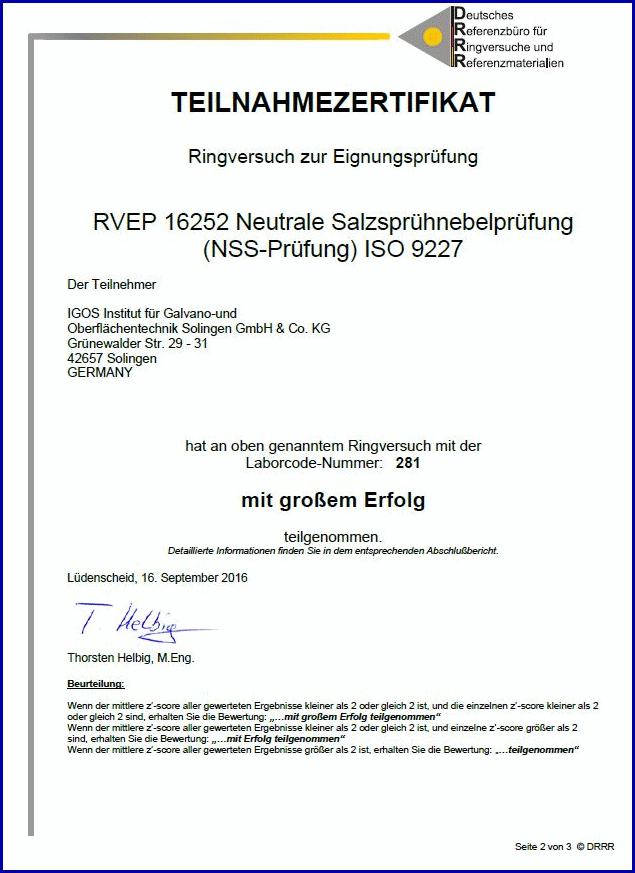In the course of this accreditation, a quality management system was introduced which complies with the requirements of DIN 9001. "Testing and calibration laboratories that comply with this International Standard will therefore also operate in accordance with ISO 9001" (also taken from the Introduction to DIN EN ISO 17025).
You can access the accreditation document and its appendices in the download section.
The validity of our accreditation certificate can be checked in the database of accredited laboratories on the DAkkS homepage.
Interlaboratory comparison 2016 for salt spray tests to DIN EN ISO 9227-NSS passed "with flying colours".
Salt spray testing is, no doubt, the most commonly conducted corrosion test. It is used for examining corrosion protected components or for appraising the corrosion behaviour of workpieces made of various materials.
The automotive and aviation industries make extensive use of the salt spray test as an accelerated ageing and corrosion test, applied as part of the standard range of tests. A rise in worldwide trade with industrial products has resulted in increased demands on corrosion resistance levels of products sold to many different climatic zones.
This was the main reason behind the decision to unify salt spray testing worldwide in the internationally recognised DIN EN ISO 9227 standard and to apply continuous improvement through regular updates, also at an international level. Many customer-specific standards and terms of delivery make a direct reference to this international standard, which is why it is frequently applied in connection with part submission warrants (PSWs) and for monitoring quality in production.
IGOS has been performing these tests since 1997, i.e. for close to 20 years now. When IGOS was first accredited to DIN EN ISO 17025 in 2006, salt spray testing using a range of different test solutions was one of the first accredited test procedures at this Institute.
To guarantee both the national and international comparability of our inspection and testing procedures, we, as an accredited testing laboratory, are required to take part in comparisons with other laboratories. For this reasons, we participate in publicly tendered interlaboratory comparisons and suitability tests.
This year, we have already taken part in four such round-robin tests for salt spray tests to DIN EN ISO 9227 NSS (neutral salt spray testing). Factors appraised are the corrosiveness of the testing chamber, the corrosion resistance of lacquered test panels, delamination and corrosion creep of the lacquer finish at an artificially applied point of damage. The corrosion creep or delamination is evaluated to DIN EN ISO 4628-8 and the degree of blistering to DIN EN ISO 4628-2.
IGOS's success was confirmed for the fourth time in succession after the latest interlaboratory comparison "with flying colours". Without doubt, this success is a result of the many years of experience and capability of the employees at IGOS in connection with corrosion testing.
The experience inherent in IGOS is also appreciated by our clients when it comes to other corrosion tests that involve different, often adapted, test requirements (such as other concentrations of salts, modified salt compounds), tests combined with other corrosion testing alternatives - termed alternating atmosphere tests (combination of salt spray phases, water condensation phases and simulated climates and, where appropriate, combined with various rain sprinkler options).
 Deutsch
Deutsch
 English
English



